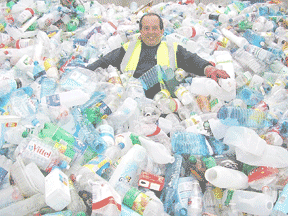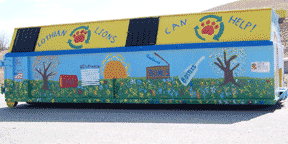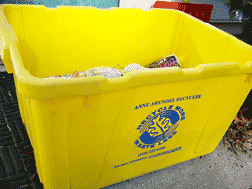Can That Be Recycled?
Average isn’t good enough when it comes to keeping recyclables out of our fast-filling landfills
by Carrie Madren, Bay Weekly staff writer
Dedicated recyclers put every trash-bound item to one test: Can it be recycled?
If it passes the test, the item lands in the recycling bin for new life. If not, it heads to the landfill to take up space in our vast, accumulating mountains of trash.
To extend the life of our landfills, Anne Arundel County has launched a quarter-million-dollar campaign to reach a history-making goal: to raise our residential recycling rate from 30 percent to 50 percent in the next six years. To make it work, you’ll have to transform yourself into an ultra-recycler who re-routes toilet paper tubes, phone books, cereal boxes and junk mail into the plastic tub.
In Anne Arundel, Recycle.More.Often
Becoming an ultra-recycler doesn’t require cape and super powers. It does call for changes in thinking and motivation.
The average Anne Arundel County household tosses away about one ton of waste — trash and recyclables — each year. Anne Arundel’s 178,000 households recycled only 67,000 tons — while trashing 148,000 tons.
To reverse those numbers, here’s the first question you’ll have to ask yourself: What did you throw away that could have been recycled? Does your commitment extend to toilet paper tubes?
“We know that there are recyclables in there that could have been recycled, but now they’re entombed in a landfill,” says Jim Pittman of the county’s Waste Management Services.
Pittman knows because trash detectives have investigated your garbage, sniffing out hidden recyclables headed for the landfill instead of the recycling plant.
“We have done studies where we statistically sampled some of the trash from county routes and had workers sort through and do a compilation study,” Pittman reports. From random county streets, trash detectives found laundry detergent bottles, magazines, paperback and hardcover books, home, office and school papers, junk mail, telephone books, paper towel rolls and shampoo bottles — all headed for the dump.
To leap from average recycling to ultra recycling, you must set higher standards of categorization.
That’s not as hard as it might sound. In Anne Arundel, sorting recyclables into categories is archaic. Now, a gargantuan, high-tech, single-stream recycling machine sifts and sorts our recyclables for us.
Match that smart, hard-working machine with ultra-recyclers, and Anne Arundel County will reclaim some 30,000 tons of recyclables from the trash. That’s how much recycling Pittman estimates we now throw away every year.
That’s like throwing away money. Last year, our 67,000 tons of recyclables added $1.8 million to the county budget.
The cash-strapped county stands to gain $1.4 to $2 million for our extra efforts. Our cast-out aluminum, paper and plastic are bought by companies that shred and melt used materials to make new products.
“We earn $40 to $50 per ton for recyclables,” Pittman says. Paper is the lion’s share of our recycling, he reports, and paper fetches the highest prices in today’s market.
“About half of all paper products that people put in their trash should be recycled,” County Executive John Leopold says.
By recognizing our trash as recyclables, we may help save ourselves tax increases.
Ultra-recyclers can also help slow down the speed at which our landfills fill up. Anne Arundel countians have been filling the 540-acre Millersville Landfill since the early 1970s. After dumping some 2.5 billion tons of solid waste, we’re loading up cell eight — out of only nine cells. Landfill manager Rich Bowen predicts that we’ll fill cell eight before 2014. With our current trash habits, cell nine should last until 2050.
County Executive Leopold issued the official call to action last week. A new $250,000 campaign, Recycle.More.Often, includes television and print advertisements, contests with prizes and a new website. County funds also have been set to hire two new recycling educators to help moderate recyclers transform their trash habits.
You can also now take your ultra-recycling ethic to work.
Until now, businesses that wished to recycle have had to make their own arrangements. Many simply didn’t, though eco-conscious business owners — including Bay Weekly’s CEO Alex Knoll — haul their office recycling to county centers. In February, the County Council passed a bill to establish fee-based county recycling pickup for small businesses.
Starting in July, recycling trucks will pick up curbside bins from businesses that pay recycling fees of at least $75 a year, based on how many bins they fill.
Soon we’ll also be able to recycle where we play. School children decorated four, huge, painted, dumpster-type recycling containers to be placed in county parks.
Anne Arundel’s recycling rate has hovered at 30 percent since 1992, so we’ll have to be ultra-conscientious — at home, work and play — to reach the new goal of 50 percent.
In Calvert, Working Harder to Do More
Calvert Countians have a different challenge. It’s harder work raising the recycling rate there for two reasons. First, Calvert is recycling more than Anne Arundel. The county met its 40 percent residential recycling goal in 2003.
Second, most countians — except those in the Twin Beaches — must manage their own recycling from start to finish, sorting their recycling, rinsing their bottles and cans and stacking their paper. Then they’ve got to haul their recycling loads to one of the county’s six recycling centers or the Appeal Landfill in Lusby.
Only one of the Appeal Landfill’s five cells has filled up in the 15 years the landfill’s been open. That’s a tribute to Calvert recyclers’ saving ways. But there, as in Anne Arundel, there’s good reason to do better. At the current rate of 148,000 tons of trash per year, Appeal will fill up in less than two decades.
Calvert ultra-recyclers can lengthen the life of their landfill by adding to their list of recyclables, including more types of plastics.
“Through the market, we were able to expand the plastics accepted for recycling,” says Calvert recycling coordinator Bill Teter. “In addition to One and Two plastics, we can now take Three through Seven.”
More types of cardboard can be rerouted from the landfill, too. “Now we can accept flattened pressboard, like you get with soda packs or cereal boxes,” Teter adds.
Cast-off electronics take up lots of unnecessary landfill room — as well as adding their toxic components to the Earth’s burden. To save that space, Calvert recyclers can drop off electronics — DVD players, fax machines and computers, for instance, but no televisions — for recycling any day of the year at five county recycling centers.
Boosting their already good habits will bring in more money for Calvert County as well as save landfill space: last year, recycling added over $200,000 to the county’s wealth.
Rising Above Average
Calvert already surpassed the national average of 32 percent recycling. If Anne Arundel County can raise its recycling rate to 50, both counties will rise to well above average.
The key, says Anne Arundel’s Pittman, is “to get emotionally involved in the effort.”
Ultra-recycling, in other words, takes passion.